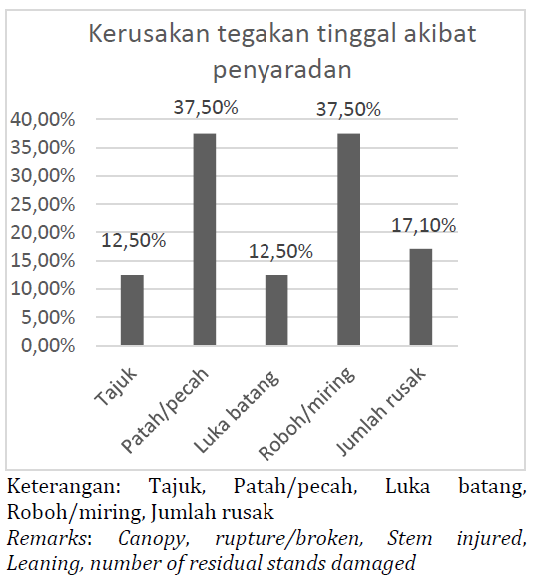RIL Skidding Techniques to Improve Productivity and Minimize Production Cost and Environmental Damage (A Case Study at PT Inhutani II Malinau)

Conventional skidding techniques applied in natural forests often bring low productivity, high skidding cost, residual stands damage, and soil damage. RIL’s (Reduced Impact Logging) skidding techniques with better performance and more environmentally friendly should be introduced. This study aims to determine the effect of RIL’s skidding techniques on skidding productivity, skidding production-cost, and environmental damages that comprised residual stands and soil inside natural forests. This research was conducted in November-December 2015 at the site of natural production forest administered by PT. Inhutani II (Indonesia’s State Forest Company), in North Kalimantan. The acquired field data, which consisted of productivity, skidding cost, and damages of residual stands and of soil, were each processed into tabulation forms and then calculated for their averages. The results showed that applying RIL techniques could obtain: 1) The average skidding productivity reached 15.070 m3/hour; 2) The average skidding-production cost was IDR 48,883.45/m3; 3) The skidded-timber volume and skidding duration correlated with the average of skidding productivity, with coefficient of determination of 96.4%; 4) The average damage on residual stand due to skidding was 17.10% including canopy damage (12.5%), broken stems (37.5%), stem injury (12.5%), and leaning trees (37.5%), 5). Average soil depth and soil volume due to the topsoil displacement were 0.047 m and 3.726 m3/m; and 6) the use of matting strips can reduce the occurrence of soil damage during skidding.
Bembenek, M., Mederski, P. ., Erler, J., & Giefing, D. . (2011). Results of large-size timber extracting with a Grapple Skidder. Acta Sci. Pol. Sil. Colendar. Rat. Ind. Lignar, 10(3), 5–14.
Elias. (2015). Pengertian dan perkembangan IPTEKS pemanenan kayu. Bogor: PT Media Anugrah Perkasa.
Elias. (2016). Penerapan Reduced Impact Logging dalam rangka reformasi eksploitasi hutan dan korupsi dalam pengelolaan hutan alam tropika Indonesia (Orasi Ilmiah). Bogor: Institut Pertanian Bogor.
FAO. (1992). Cost control in forest harvesting and road construction (Paper 99). Rome: The United Nations.
Gilanipoor, N., Najafi, A., & Alvaezin, S. M. H. (2012). Productivity and cost of farm tractor skidding. Journal of Forest Science, (1), 21–26.
Idris, M.M., & Soenarno. (2015). Unjuk kerja teknik penyaradan kayu dengan metode tree length logging pada hutan alam lahan kering. Jurnal Penelitian Hasil Hutan, 33(2), 153-166.
Missanjo, E., & Thole, G.K. (2014). Impact of site disturbances from harvesting and logging on soil physical properties and pinus kesiya tree growth. International Scholarly Research Notices, page 1-8.
Muhdi, Sucipto, T.,& Widyanti, M. (2006) Studi produktivitas penyaradan kayu dengan menggunakan traktor Komatsu D70 LE di hutan alam. Jurnal Komunikasi Penelitian, 18(3), 7-13.
Muhdi. (2015). Analisis biaya dan produktivitas penyaradan kayu dengan traktor Caterpillar D7G di hutan alam tropika basah PT Inhutani II, Kalimantan Utara. Jurnal Penelitian Ekosistem Dipterokarpa, 1(2), 63–68.
Naghdi, R., Lotfalian, M., Bagheri, I., & Jalali, A. M. (2009). Damages of skidder and animal logging to forest soils and natural regeneration. Croatian Journal of Forest Engineering, 30(2), 141–149.
Ozturk, T. (2014). Productivity and cost of rubber-wheel-tyred tractor in a Northern pine plantation forest of Turkey. Baltic Forestry, 20(2), 272-276.
Siswanto, H. (2010). Kajian input dan output penyaradan pada pengusahaan hutan di Kalimantan Timur. Jurnal Eksis Riset, 6(2), 1440–1605.
Solgi, A., & Najafi, A. (2014). The impacts of ground-based logging equipment on forest soil. Journal of Forest Science, 60 (1), 28-34.
Stan czykiewicz, A., Sowa, J. M., Kulak, D., Leszczyn ski, K., & Szewczyk, G. (2012). Damage to trees and regeneration layer resulting from timber harvesting with the use of equipment aggregated with farm tractors in thinned pine stands. Acta Sci. Pol. Sil. Colendar. Rat. Ind. Lignar, 11(2), 37–51.
Stan czykiewicz, A., Szewczyk, G., & Kulak, D. (2015). Damage to advance growth resulting from timber harvesting during final cuttings. Baltic Forestry, 21(2003), 144–151.
Suhartana, S., Idris, M. M., & Yuniawati. (2011). Penyaradan kayu sesuai standar prosedur operasional untuk meningkatkan produktivitas dan meminimalkan biaya produksi dan penggeseran lapisan tanah atas : Kasus di satu perusahaan hutan di Jambi. Jurnal Penelitian Hasil Hutan, 29(3), 248–258.
Suhartana, S., Dulsalam.,&Idris, MM. (2000). Penyaradan terkendali utk minimasi penggeseran lapisan tanah atas dan keterbukaan lahan:Kasus di satu perusahaan hutan di Kalteng. Buletin PHH, 17(4), 209-219.
Suhartana, S., & Yuniawati. (2015). Peningkatan produktivitas penyaradan kayu Acacia crassicarpa melalui penerapan teknik ramah lingkungan. Jurnal Hutan Tropis Borneo, 3(2), 116–123.
Thaib, J., & Suhartana, S. (1991). Keadaan jalan sarad dan pohon ditebang pada tegakan tinggal di kawasan sebuah perusahaan hutan di Riau. Jurnal Penelitian Hasil Hutan, 9(4), 144–149.

